MONTHLY FIELD VETERINARY REPORT FOR MASAI MARA-DECEMBER 2016 By Dr
MONTHLY FIELD VETERINARY REPORT FOR MASAI MARA-DECEMBER 2016
By Dr. Campaign Limo
Introduction
The area experienced a dry spell that lasted almost the entire month with resultant decrease in forage and readily available water for wildlife. Most ungulates were seen aggregating close to swampy areas which are drying up quickly. Most elephants have moved to the surrounding conservancies with several predator conflict cases involving lions and domestic sheep and goats reported. One lone sub adult lioness was hungry and emaciated and had to be relocated after camping next to a livestock shed in a community area having killed sheep.
The following cases were handled during the month;
CASE#1 TREATMENT OF AN INJURED ELEPHANT COW
Date: 6th Dec 2016
Species: African elephant
Sex: Female
Age: Adult
Location: Olare Motorogi conservancy
History
This elephant, who appeared to be the matriarch of the family, was spotted with a swollen ventral abdominal area by the Olare Motorogi rangers who informed their management who in turn called the Vet unit for help. It was reported that the elephants had just recently migrated to the Conservancy.
This elephant was in a group of about ten elephants and was nursing a four year old calf. Her entire ventral abdomen was swollen, extending from sternum all the way to the vulva. The vulval lips were swollen and slightly evaginated. A small wound suspected to have been caused by an arrow was seen ventrally slightly behind the left teat.
Immobilization, examination and treatment
Restraint was achieved chemically by use of 15mgs Etorphine hydrochloride delivered in a 1.5ml dan-inject dart from a vehicle. The drugs took effect after eight minutes with this elephant assuming right lateral recumbency. Other members of the family were highly protective and driven away to give room for this matriarch to be attended to.
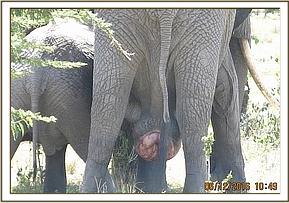

Closer examination revealed she had an injury to her left ventral thoracic area which was septic with purulent material accumulating. The extended ventral swelling was purulent material and tissue reaction due to the injury. All this extended to the vulva. Luckily, micturition functions were not interfered with as the urethra and vulval opening were patent. The opening of the injury was surgically extended and a lot of pus drained. Much of the necrotic tissues were removed and an arrow head retrieved. The injury occurred approximately two weeks prior and from the damage observed, this could have been a poisoned arrow. Another opening was created further ventrally for maximum drainage of pus.The wounds were debrided with Hydrogen peroxide to remove as much of the pus and necrotic tissue as possible. Clean water was then used to rinse before flushing with tincture of iodine.
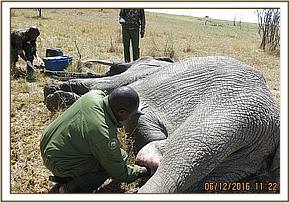

Additional treatment included 200mgs Dexamethasone sodium anti-inflammatory, half the dose given intravenously and the remainder half given intramuscularly. She also received 30000mgs Amoxicillin antibiotic given intramuscularly.
Reversal
Reversal of the anaesthetic was achieved by intravenous administration of a combination of 30mgs Diprenorphine hydrochloride and 150mgs Naltrexone intravenously through a prominent ear vein. She woke up in three minutes to join the other family members. The Conservancy management was tasked to monitor this elephant and report progress with possibilities of repeat treatment depending on the response.
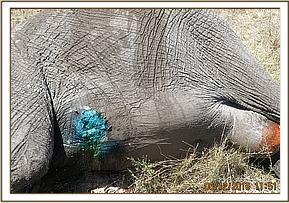

Prognosis
Fair.
CASE#2 RELOCATION AND TREATMENT OF A PROBLEMATIC LIONESS
Date: 8th Dec 2016
Species: African lion
Age: Sub adult
Sex: Female
Location: Aitong
History
This lone lioness was reported to have entered a livestock boma the night of the 7th December and killed a sheep though it was chased away before feeding on it. With recent spiralling cases of predation of domestic animals in the surrounding areas by lions, the villagers were irate and wanted to kill the lioness. She had not moved far but took refuge in a small shrub close to the boma and KWS security personel called the unit for intervention.
Capture, treatment and re-location
She was located in a small thicket at a Lugga alone and emaciated. Clearly she appeared to have a problem and hungry.
She was immobilized by use of a combination of 4mgs Medetomidine and 150mgs Ketamine hydrochloride. It took seven minutes for her to be fully anaesthetized and immediate examination revealed she had not fed for some time and she had a suspected spear injury to her left hip. The septic wound was debrided with reconstituted Hydrogen peroxide and rinsed with clean water. This was then wiped with gauze swab before tincture of Iodine and Cloxacillin ointment were infused. Additional treatments included parenteral administration of 14mgs dexamethasone sodium anti-inflammatory and 2250mgs amoxicillin antibiotic. She also received 40mgs ivermectin parasiticide subcutaneously.
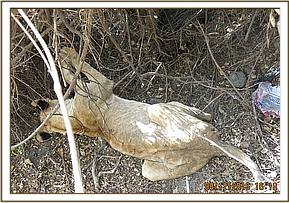

She was identified to belong to the Off Beat pride of lions in Mara North Conservancy and had strayed away from the rest of the pride. She was placed in a cage and transported under anaesthesia to the location of the pride where she was offloaded and the anaesthetic reversed. She woke up after 15 minutes with the Mara North Rangers being tasked to watch over her until she became strong enough to join her pride.
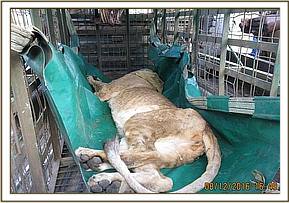

Prognosis.
Good with feeding.
CASE#3 TREATMENT OF A SPEARED OSTRICH
Date: 10th Dec 2016
Species: Masai Ostrich
Sex: Male
Age: Adult
Location: Makaria area (Masai Mara National Reserve)
History
This Ostrich with a spear head sticking from his rear abdomen was seen by visiting tourists. They requested help from the Unit and notified the reserve security team who were part of the search team. They also lent a hand in handling during treatment. This ostrich was alone and appeared to be in severe pain choosing to lie down frequently. He was bleeding from the spear wound with the spear head protruding from his abdomen.


Immobilization, examination and treatment
Immobilization was achieved by use of a combination of 4mgs Etorphine hydrochloride and 4mgs Medetomidine delivered in a 1.5ml dan-inject dart from a vehicle. It took ten minutes for the drugs to take full effect and the ostrich was approached and restrained physically when he became wobbly. The spear head dropped out on capture leaving a penetrating wound from the right part of the lower rear abdomen exiting on the left side. The spear caused partial damage to the cloaca with bloody discharge by the ostrich on attempt to defeacate.
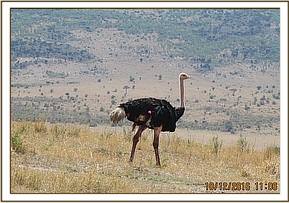

The wounds were flushed with sterile water and all the bleeders ligated. Tincture of Iodine disinfectant was applied and wounds closed with chromic cat gut suture. Cloxacillin antibiotic ointment was also infused into the wounds. Additional treatment included parenteral administration of 3000mgs Amoxicillin antibiotic.
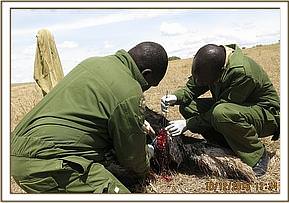

Reversal
Reversal of the anaesthetic was achieved by administration of a combination of 15mgs Atepamezole hydrochloride and 75mgs Naltrexone intramuscularly. He got up after fifteen minutes and walked away.

Prognosis
Guarded. He had lost a lot of blood and showed some degree of anaemia.
CASE#4 DE-SNARING OF A ZEBRA
Date: 11th Dec 2016
Species: Common zebra
Sex: Male
Age: Young adult
Location: Kawai (Trans Mara)
History
Members of Ann K. Taylor De-snaring team found this zebra with a plain wire snare round his neck while on their normal duties. This young male was seen grazing with a group of other zebras in a community area. A shiny plain wire was seen round his neck. He was dragging the loose part which hindered his movement and feeding. He also appeared stressed and nervous.
Immobilization and de-snaring
The zebra was restrained by use of a combination of 5mgs Etorphine hydrochloride and 50mgs Azaperone delivered in a 1.5ml dan-inject dart. It took five minutes for the drugs to take full effect with the zebra assuming right lateral recumbency. Examination revealed this was a plain wire snare that was tight on his neck but without injuries. It could have been in place for less than a week. The wire was removed and without any noticeable injuries, the anaesthetic was reversed.


Reversal
Reversal of the anaesthetic was achieved by intravenous administration of a combination of 50mgs Naltrexone and 12mgs Diprenorphine through the jugular vein. He woke up after four minutes to join the rest who were grazing nearby.
Conclusion
Mara Mobile Veterinary Unit is grateful to all the stakeholders who partnered with them in many treatments and rescues carried out throughout the year. Much appreciation to Minara Foundation through The DSWT for their continuous facilitation of the unit. Thanks to KWS management for their technical guidance in the running of the unit.
MERRY CHRISTMAS AND A HAPPY NEW YEAR TO YOU ALL.

























